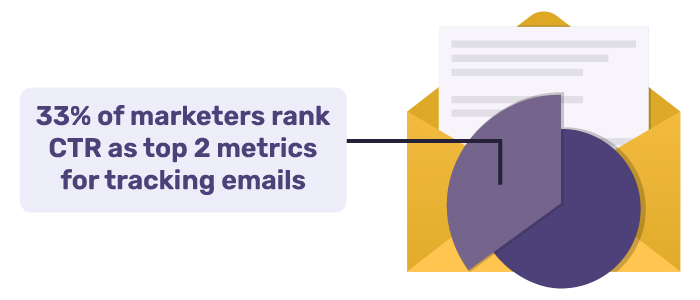Top Email Marketing KPIS for Insanely High ROI
There are almost 4.5 billion email users worldwide. This means that over half of the world’s population uses email to communicate, read the latest news, or do other similar activities. And with such a terrific number on the table, it is no wonder marketers choose to include emails in their marketing strategy.
However, just as email marketing can have an ROI as high as $36 for each dollar spent, it can also bring less to no results for some brands. This usually depends on how an email marketing strategy is built and especially how a team works to improve it.
As every process can constantly be improved, email marketing should not be left behind. To do that, marketers should always check some genuinely helpful email marketing KPIs.
Thus, in this article, we will discuss some email marketing KPIs that can entirely transform a brand’s campaign and, most importantly, results.
1. Delivered Emails is the Most Ignored Email Marketing KPI
Successfully sending your email to the whole newsletter list should be essential. This is why you should check the total number of emails delivered – in other words, your delivery rate.
This email marketing KPI shows how many emails have been successfully sent out. For instance, if your email list has 150,000 addresses and the number of delivered emails is 135,000, it means that 15,000 emails could not reach the recipients for some reason.
These are some of the main reasons for not being able to deliver an email:
- You have the wrong email address;
- The receiving email server is overloaded, unavailable, or cannot be found.
Usually, when you cannot deliver an email to a particular address, it would be great to remove the address from your email list so that the number of undelivered emails will decrease. However, if the email server is overloaded, you may want to try sending the email again sometime later.
2. Open Rate is the Gate Keeper of Your Email Marketing Success

The open rate is the percentage of email receivers who open a specific email.
For example, if your list contains 150,000 email addresses and 50,000 open an email, your open rate will be 33.3%. According to Campaign Monitor, the average open rate across all industries is 21.5%.
However, the open rate can be a little misleading. While some platforms count emails as opened when users simply open them, others consider an email opened only if the recipient enables images to be displayed or clicks on a link from the email. Thus, marketers should also consider their CTR when tracking this email marketing KPI.
Furthermore, to increase your open rate, you should consider that users usually open emails if they are intrigued by the sender’s name, the subject line, the offer, or the first paragraph.
3. Click-through Rate is Perhaps the Most Important Email Marketing KPI

When you ask email marketers what they pay most attention to, they often discuss click-through rate (CTR), and that’s because CTR is really important in email marketing.
The click-through rate shows the percentage of email subscribers who click on a link in an email. So, it tells you how well your email is getting people to take action and visit a website or do something else.
For example, if your list consists of 150,000 successfully delivered emails, and you have 7,500 clicks, your CTR will be 5%.
According to Campaign Monitor, a good email CTR should range between 2-5%, depending on the brand’s industry.
Usually, when a business needs to improve its email CTR, it should focus primarily on the content included in the email, as relevancy will increase the email click-through rate. Furthermore, marketers can personalize the emails they send because, according to Bluecore’s report, personalization can increase the CTR by 139%.
4. Immediately After Clicks, You Need to Look at Conversions
The conversion rate is the percentage of email receivers who not only clicked on a link in the email but also completed a particular action on the website. Even if we are talking about ordering something or completing a form, these subscribers increase the number of conversions.
For instance, if you have delivered 150,000 emails and 1,500 purchased a product, your conversion rate will be 1%.
In this regard, there are multiple aspects marketers can improve to increase the email conversion rate.
Firstly, they can automate some processes in the email marketing campaign. For example, when a user clicks on a link but does not complete any action, they can automatically receive an email reminding them to go on the website and complete it.
Furthermore, since 41% of all emails are opened from a smartphone, emails should always be mobile-friendly.
Other things that can increase conversions include adding links to images and using strong CTAs.
5. Bounce Rate is More Important Than It Seems
First, we must clarify that the delivery and bounce rates differ. The delivery rate refers to the number of emails the receiving server accepts. On the other hand, the bounce rate is an email marketing KPI that counts the emails that couldn’t be delivered and were returned to you.
The bounces can be either soft or hard. Soft bounces can occur due to temporary problems with specific email addresses. For instance, the recipient can have the inbox full, or their email server may not work at that particular time. When marketers notice soft bounces among their sent emails, they can try to send the email again later.
Hard bounces, on the other hand, usually mean that you’re trying to send emails to closed, invalid, or non-existent email addresses. Such recipients should be removed from the email list immediately, as they might affect your overall performance.
This issue can simply be solved by sending a verification email right after a user subscribes to the newsletter. This way, they must verify their email before being added to the email marketing list.
6. The Unsubscribe Rate is More Than Just About Relevancy

Another KPI for email marketing worth tracking is the unsubscribe rate. This is the percentage of email addresses unsubscribed after opening a particular email.
Even though some users do not unsubscribe if they are not interested in your brand anymore, the unsubscribe rate can still be a significant KPI for an email marketing campaign. Furthermore, once you can track this email marketing KPI along with the CTR (Click-through rate) and CR (conversion rate), you will have a more detailed picture of your campaign’s success.
Usually, to have a lower unsubscribe rate, marketers can do the following:
- Ask for feedback;
- Send follow-up emails; a user who recently unsubscribed is not lost forever;
- Segment your email list by interest;
- Check your copy and see if there are some improvements you can make.
7. Keep an Eye on Email Marketing Growth KPIs – List Growth Rate
The list growth rate shows how fast the email list grows, considering both new subscribers and unsubscribers.
This email marketing KPI is vital to watch, as it shows you how many new conversion opportunities can come from your email list.
To increase the list growth rate, marketers can offer something for those who subscribe to their newsletter, for example. Many websites offer a 10% discount on the first order for such users. Furthermore, the sign-up should be easy to complete, and it would be great if the copy suits the user who receives it. For instance, you can try to send different emails based on gender, age, and interests.
While the list growth rate is extremely important for an email marketing campaign’s success, businesses should always work on keeping their subscribers engaged. This way, not only will the email list grow, but there will be fewer users who unsubscribe.
8. Track Active Subscribers vs Inactive Subscribers
While tracking all the email marketing KPIs mentioned above, you may want to check how many subscribers are constantly active. Usually, active subscribers open newsletter emails, click on campaign links, and (ideally) purchase some products.
And when it comes to inactive newsletter subscribers, remember that they can become active if you send them the right content. For instance, try to remind them to access the website by offering an offer or a discount code. There is a high possibility that if the subject and the CTA engage enough, they will return and convert.
In Conclusion
Email marketing is highly scalable and great for engaging with both current and potential customers. And considering almost 4.5 billion email users, many brands have decided to include marketing in their marketing strategy.
While working on improving your campaign, you should keep an eye on some email marketing KPIs, including CTR, bounce rate, conversion rate, unsubscribe rate, and open rate.
We hope the KPIs discussed in this article will be helpful when improving your campaign to increase your ROI.